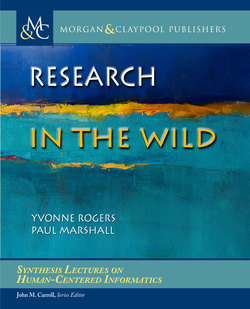Читать книгу Research in the Wild - Paul Marshall - Страница 7
На сайте Литреса книга снята с продажи.
ОглавлениеContents
Acknowledgments
1 Introduction
1.1 Research Gone Wild
1.2 How Does Research in the Wild Differ from Lab Experiments?
1.3 A Framework for HCI Research in the Wild
1.4 Scoping Research in the Wild
1.5 Aim of the Book
1.6 Summary
2 Moving Into The Wild: From Situated Cognition to Embodied Interaction
2.1 Introduction
2.2 Plans and Situated Action
2.3 Cognition in Practice
2.4 Cognition in the Wild
2.5 Embodied Interaction Approaches
2.6 Current Theorizing within RITW
2.7 Conclusion
3 Approaches to Conducting Research in The Wild
3.1 Introduction
3.2 Participatory and Provocative Approaches to Research in the Wild
3.2.1 Participatory Approaches
3.2.2 Provocative Approaches
3.3 Design Methods Used for Research in the Wild
3.3.1 Designing on the Fly during Research in the Wild Studies
3.3.2 Designing for Appropriation: How to Invite and Guide the General Public
3.4 Technologies Developed in the Wild
3.5 Methods for Conducting In Situ Studies in the Wild
3.5.1 New Ways of Collecting Data
3.6 Summary
4 Case Studies: Designing and Evaluating Technologies for Use in the Wild
4.1 Introduction
4.2 Case Study 1: The Ambient Wood Project
4.2.1 Background
4.3 Case Study 2: The Clouds and Twinkly Lights Project
4.3.1 Background
4.3.2 Theory
4.3.3 Design
4.3.4 Technology
4.3.5 In Situ Study
4.4 Case Study 3: The Physikit Project
4.4.1 Background
4.4.2 Theory
4.4.3 Design
4.4.4 Technology
4.4.5 In Situ Study
4.5 Overall Summary
5 Practical and Ethical Issues
5.1 Introduction
5.2 Practical Challenges
5.2.1 Managing Expectations
5.2.2 Identifying and Resolving Tensions
5.2.3 Dealing with the Unexpected
5.2.4 Overcoming the Novelty Effect
5.3 Ethics: Consent, Data Collection, and Permission
5.4 Publishing Research in the Wild
6 Conclusions
References
Author Biographies
